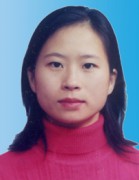
· Education and Experience
2008.05-Present State Key Laboratory of Applied Organic Chemistry, Lanzhou University,
Associated Professor
2007.01-2008.04 State Key Laboratory of Applied Organic Chemistry, Lanzhou University,
Assistant Professor
2004.09-2006.11 College of Chemistry and Chemical Engineering, Lanzhou University,
Postdoctoral Fellow
2004.07 Tianjin Medical University, Ph.D.
· Research Topics
Fluorescent probe, Nrf2 activator, Redox, Cancer chemoprevention, Medicinal chemistry, Chemical biology.
Intracellular redox active molecules play an important role in maintaining redox homeostasis and function in cells. It is a hot topic in the field of cell biology to profoundly understand or clarify the relationship between these molecules and how they regulate cell functions. Fluorescence imaging technology is a powerful tool for visualizing the fluctuation of concentration and regional distribution of these molecules due to its characteristics of real-time, sensitivity and non-invasiveness. Additionally, Activation of nuclear factor erythroid-2-related factor 2 (Nrf2) is a crucial cellular defense mechanisms against oxidative stress and also an effective means to decrease the risk of oxidative stress-related diseases including cancer. Our interests include (1) developing fluorescent probes for monitoring intracellular redox-active molecules; (2) developing Nrf2 activators for cancer chemoprevention.
· Publications
1. Fast Imaging of Mitochondrial Thioredoxin Reductase Using a Styrylpyridinium-Based Two-Photon Ratiometric Fluorescent Probe. Yong-Peng Yang†, Fu-Jian Qi†, Ya-Long Zheng, De-Chen Duan, Xia-Zhen Bao, Fang Dai*, Shengxiang Zhang*, and Bo Zhou*, Anal. Chem. 2022, 94, 4970.
2. Redox-Based Strategy for Selectively Inducing Energy Crisis Inside Cancer Cells: An Example of Modifying Dietary Curcumin to Target Mitochondria. Ya-Long Zheng, Zhi-Shan Tu, Hong-Mei Cui, Shuai Yan, De-Chen Duan, Wei Tang, Fang Dai*, and Bo Zhou*, J. Agric. Food Chem. 2022, 70, 2898.
3. Developing a Styrylpyridinium-Based Fluorescent Probe with Excellent Sensitivity for Visualizing Basal H2S Levels in Mitochondria. Bin Ma, Di-Hua Tian, Shuai Yan, Xiao-Chun Li, Fang Dai*, Bo Zhou*, Sens. Actuators B. Chem. 2021, 327, 128937.
4. A Multi-Signal M-targetable Fluorescent Probe for Simultaneously Discriminating Cys/Hcy/H2S, GSH, and SO2 and Visualizing the Endogenous Generation of SO2 in Living Cells. Ya-Long Zheng, Zuo-Hu Chai, Wei Tang, Shuai Yan, Fang Dai*, Bo Zhou*, Sens. Actuators B. Chem. 2021, 330, 129343.
5. Developing Push-Pull Hydroxylphenylpolyenylpyridinium Chromophores as Ratiometric Two-Photon Fluorescent Probes for Cellular and Intravital Imaging of Mitochondrial NQO1. Yong-Peng Yang, Fu-Jian Qi, Yi-Ping Qian, Xia-Zhen Bao, Han-Chen Zhang, Bin Ma, Fang Dai*, Sheng-Xiang Zhang*, Bo Zhou*, Anal. Chem. 2021, 93, 2385-2393.
6. Cooperation of ESIPT and ICT Processes in the Designed 2-(2′-Hydroxyphenyl)benzothiazole Derivative: A Near-Infrared Two-Photon Fluorescent Probe with a Large Stokes Shift for the Detection of Cysteine and Its Application in Biological Environments, Ying Long, Junru Liu, Dihua Tian, Fang Dai*, Shengxiang Zhang,* and Bo Zhou*. Anal. Chem. 2020, 92, 14236-14243.
7. Applying an Electrophilicity-Based Strategy to Develop a Novel Nrf2 Activator Inspired from Dietary [6]-Shogaol, Yuting Du, Yalong Zheng, Yuan Ji, Fang Dai*, Yongjing Hu, and Bo Zhou*. J. Agr. Food Chem. 2018, 66, 7983-7994.
8. Structural basis, chemical driving forces and biological implications of flavones as Cu(II) ionophores. FangDai, Wenjing Yan, Yuting Du, Xiazhen Bao, Xiuzhuang Li, and Bo Zhou*. Free Radical Bio. Med. 2017, 108, 554-563.
9. Design, synthesis, and evaluation of curcumin derivatives as Nrf2 activators and cytoprotectors against oxidative death. Zhishan Tu, Qi Wang, Dandan Sun, Fang Dai*, and Bo Zhou*. Eur. J. Med. Chem. 2017, 134, 72-85.
10. Insights into the importance for designing curcumin-inspired anticancer agents by a prooxidant strategy: The case of diarylpentanoids. Fang Dai, Guoyun Liu, Yan Li, Wenjing Yan, Qi Wang, Jie Yang, Dongliang Lu, Dejun Ding, Dong Lin, and Bo Zhou*. Free Radical Bio. Med. 2015, 85, 127-137.
11. Toward an understanding of the role of a catechol moiety in cancer chemoprevention: The case of copper- and o-quinone-dependent Nrf2 activation by a catechol-type resveratrol analog. Dong Lin, Fang Dai, Landi Sun, and Bo Zhou*. Mol. Nutr. Food Res. 2015, 59, 2395-2406.
12. 3, 4-dimethoxystilbene, a resveratrol derivative with anti-angiogenic effect, induces both macroautophagy and apoptosis in endothelial cells. Lu Zhang, Hongjuan Jing, Liuqing Cui, Huanqing Li, Bo Zhou, GuangZhou Zhou, and Fang Dai*. J.Cell Biochem. 2013, 114, 697-707.
13. Antioxidative Effects of Curcumin and its Analogues against the Free-radical-induced Peroxidation of Linoleic Acid in Micelles. Fang Dai, Weifeng Chen, Bo Zhou*, Li Yang, Zhongli Liu. Phytother. Res. 2009, 23, 1220-1228.
14. Antioxidant synergism of green tea polyphenols with α-tocopherol and L-ascorbic acid in SDS micelles. Fang Dai, Weifeng Chen, and Bo Zhou*. Biochimie 2008, 90, 1499-1505.